The epithelial tissue
The epithelial tissue are refered as epithelium.
It has a free surface which faces either a body fluid or outside environment and thus provides a covering or a lining for some part of the body.
The cells are compactly packed with little intercellular matrix. There are two types of epithelial tissues as follows:
Simple epithelium
It is composed of a single layer of cells and functions as a lining for body cavities, ducts, and tubes.
On the basis of structural modification of the cells, the simple epithelium is further divided into three types:
1. Squamous epithelium
The squamous epithelium is made of a single thin layer of flattened cells with irregular boundaries.
They are found in the walls of blood vessels and air sacs of lungs and are involved in functions like forming a diffusion boundary.
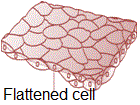
2. Cuboidal epithelium
The cuboidal epithelium is composed of a single layer of cube-like cells.
This is commonly found in ducts of glands and tubular parts of nephrons in kidneys and its main functions are secretion and absorption.
The epithelium of proximal convoluted tubule (PCT) of nephron in the kidney has microvilli.

3. Columnar epithelium
The columnar epithelium is composed of a single layer of tall and slender cells.
Their nuclei are located at the base. Free surface may have microvilli.
They are found in the lining of stomach and intestine and help in secretion and absorption.

Their function is to move particles or mucus in a specific direction over the epithelium. They are mainly present in the inner surface of hollow organs like bronchioles and fallopian tubes.
Some of the columnar or cuboidal cells get specialised for secretion and are called glandular epithelium.
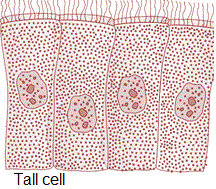
The glandular epithelium are mainly of two types:
| 1. Unicellular | 2. Multicellular |
|---|---|
| It is consisting of isolated glandular cells (goblet cells of the alimentary canal) | It is consisting of cluster of cells (salivary gland). |
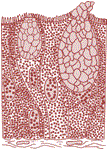 |
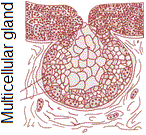 |
On the basis of the mode of pouring of their secretions, glands are divided into two categories as:
a. Exocrine glands
Exocrine glands secrete mucus, saliva, earwax, oil, milk, digestive enzymes and other cell products. These products are released through ducts or tubes.
b. Endocrine glands
In contrast, endocrine glands do not have ducts. Their products called hormones are secreted directly into the fluid bathing the gland.
compound epithelium
The compound epithelium consists of two or more cell layers and has protective function as it does in our skin.
Compound epithelium is made of more than one layer (multi-layered) of cells and thus has a limited role in secretion and absorption.
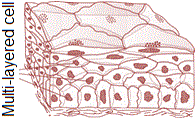
Their main function is to provide protection against chemical and mechanical stresses.
They cover the dry surface of the skin, the moist surface of buccal cavity, pharynx, inner lining of ducts of salivary glands and of pancreatic ducts.
All the cells in epithelium are held together with little intercellular material.
Mostly animal tissues, specialised junctions provide both structural and functional links between its individual cells. Three types of cell junctions are found in the epithelium and other tissues as follows:
1. Tight junctions
It help to stop substances from leaking across a tissue.
2. Adhering junctions
It perform cementing to keep neighbouring cells together.
3. Gap junctions
It facilitate the cells to communicate with each other by connecting the cytoplasm of adjoining cells, for rapid transfer of ions, small molecules and sometimes big molecules.
Epithelial Tissue Cells with location and function
| Cells | Locations | Function |
|---|---|---|
| Simple squamous epithelium | ||
| Simple cuboidal epithelium | In ducts and secretory portions of small glands and in kidney tubules | Secretes and absorbs |
| Simple columnar epithelium | ||
| Pseudostratified columnar epithelium | Ciliated tissue lines the trachea and much of the upper respiratory tract | |
| Stratified squamous epithelium | Lines the esophagus, mouth, and vagina | Protects against abrasion |
| Stratified cuboidal epithelium | Sweat glands, salivary glands, and mammary glands | Protective tissue |
| Stratified columnar epithelium | The male urethra and the ducts of some glands. | Secretes and protects |
| Transitional epithelium | Allows the urinary organs to expand and stretch |
